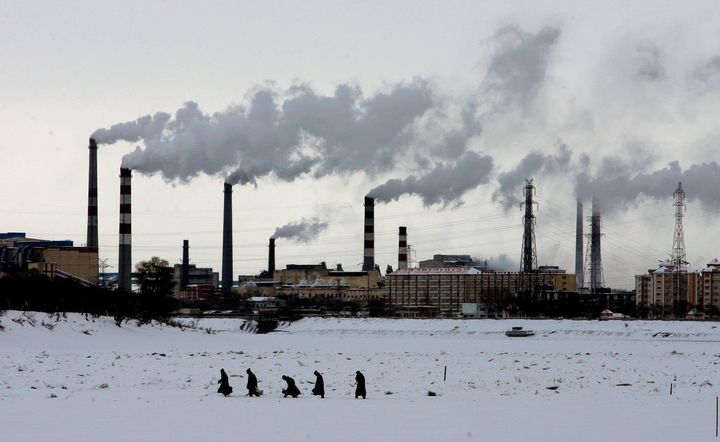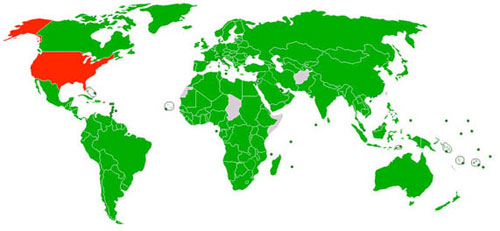
Originally published at TheGreenGrok.com.
Everyone knows that Kyoto was a failure. Right? "Scientists Say Kyoto Protocol Is 'Outdated Failure,'" "Lessons of Kyoto," "Commission Does Little About Climate Change."
When the ink dried on the climate treaty negotiated in Kyoto, Japan, on December 11, 1997, it's fair to say that many of us expected the agreement would prove to be a watershed moment in the international effort to address global warming -- as a result of the treaty, we hoped, global emissions of greenhouse gases would stop their inexorable climb upward and reverse direction.
Alas, that did not happen. Since 1997, rather than decreasing or even stabilizing, global emissions from fossil fuels have increased by 28 percent: from 22,849 million metric tons of carbon dioxide (CO2) per year to 29,320 million metric tons. An "abject failure," right? Well, yes, if you accept the premise that Kyoto's goal was to reduce global emissions. Actually, it wasn't.
The Protocol's Framework
By the end of 1992, much of the world community, including the United States, had adopted the U.N. Framework Convention on Climate Change (UNFCCC) to "stabiliz[e] ... greenhouse gas concentrations in the atmosphere at a level that would prevent dangerous anthropogenic interference with the climate system." The framework did not establish any binding emissions reductions for the signatories; it simply committed them to a set of general principles. The establishment of specific emissions targets was left to a subsequent agreement: the Kyoto Protocol.
Kyoto's Specifics
While the UNFCCC's rather grand goal of avoiding dangerous climate change was also the ultimate objective of the Kyoto Protocol, its specific goal was far more modest: to reduce the collective emissions of greenhouse gases from participating industrialized countries by 5.2 percent relative to 1990. Two important things to note:
- The emissions reduction goal was limited to the industrialized or Annex B countries, not the entire world.
- While specific percentage reductions or targets were set for specific countries, these were not binding in a literal sense since countries could use a variety of trading mechanisms to get credit for emission reductions from other countries. The ultimate goal was that collectively, emissions among the industrialized nations would come down 5.2 percent.
Currently, 38 Annex B countries including the 15 from the European Union (which together account for 64 percent of 1990 global emissions) have ratified the Protocol (see table below), as have 150 developing nations (which have no binding emissions commitments under Kyoto).
Note that while the United States was on Kyoto's initial list of Annex B countries, it is not on the current list, as the U.S. Senate never ratified the treaty. (In fact, five months prior to signing Kyoto, the Senate passed, 95-0, a nonbinding Sense of the Senate resolution to reject any international climate treaty that didn't include binding targets for developing nations.)
reduction commitment
(percentage of base year
or period)
The graphic below depicts the percentage in emissions relative to 1990 for the following countries and groups of countries (from left to right):
- Annex B ratifiers: The industrialized countries that ratified Kyoto and are thus legally committed to making cuts
- EU-15: European Union
- EIT: Economies in Transition (essentially the former Soviet Union and Eastern bloc countries)
- Non-EIT: All the Annex B ratifiers without the EIT and EU nations
- United States of America
- China
- World
Percent Change in GHG Emissions in 2007 compared to 1990
To mangle a quote of Mark Twain's, the news of Kyoto's failure is premature.
As it turns out, Kyoto's Annex B countries are not only keeping up with but are in fact exceeding their Kyoto commitments. In 2007, their collective emissions were about 17 percent below the 1990 base year emissions.
Now, it must be said that the lion's share of this decrease was not the result of any new low-carbon technology or emissions policy, but the fall of the Soviet Union. With the Soviet Union's dissolution came a precipitous economic collapse, from which the nations of the former Communist bloc have yet to fully recover. In 2007, the emissions of nations with transitioning economies (EIT) were still about 37 percent below 1990 levels.
Still, the rest of the Annex B countries are not doing badly, with their collective emissions only about two percent above 1990 levels -- a much smaller percentage increase than that of the United States or China. The European Union's 15 member nations also appear to be on a course to meet their Kyoto target: in 2007, one year before the five-year Kyoto clock began, the EU-15 countries' emissions were estimated to be four percent below the 1990 baseline.
Mixed Decision
As you can see, the facts suggest it's a little early and a little misleading to declare Kyoto a failure. In all likelihood when 2012 rolls around, we will find that overall its Annex B countries will have cut emissions by more than the intended 5.2 percent.
Although this will be due in large part to the Soviet Union's break-up, the treaty did not include a stipulation for adjustments for economic eventualities. And even so, we will likely find that the EU was able to cut its emissions by five percent or more independent of the Soviet Union. Here again the current economic downturn will help.
So far from being a failure, the Kyoto Protocol looks like it will meet its very limited goals.
But all that said, Kyoto cannot be counted as an enormous success either. The global picture is rather bleak. Since 1990 and despite the treaty, global emissions from fossil fuel use have increased by almost 37 percent. Two factors undoubtedly have contributed to this:
- The enormous increase in emissions from China. Its emissions have increased by a whopping 153 percent since 1990, and China is now arguably the largest emitter. The failure to place binding emissions targets on developing economies like China was a fundamental flaw in Kyoto and one that must be rectified in the next round of negotiations (coming up in December).
- The failure of the United States to ratify Kyoto. In contrast to the European Union, the United States -- the world's largest economy and the largest emitter over the period since Kyoto was signed -- saw a 17 percent increase in its emissions since 1990. The treaty was seriously crippled by the U.S. decision not to ratify.
Now, some Americans argue against national climate legislation and international treaties by pointing to Kyoto's "failure," but I find such an argument a little ironic -- and a lot tautological -- when one of the factors that undermined Kyoto was the "failure" of the United States to ratify the treaty in the first place.
